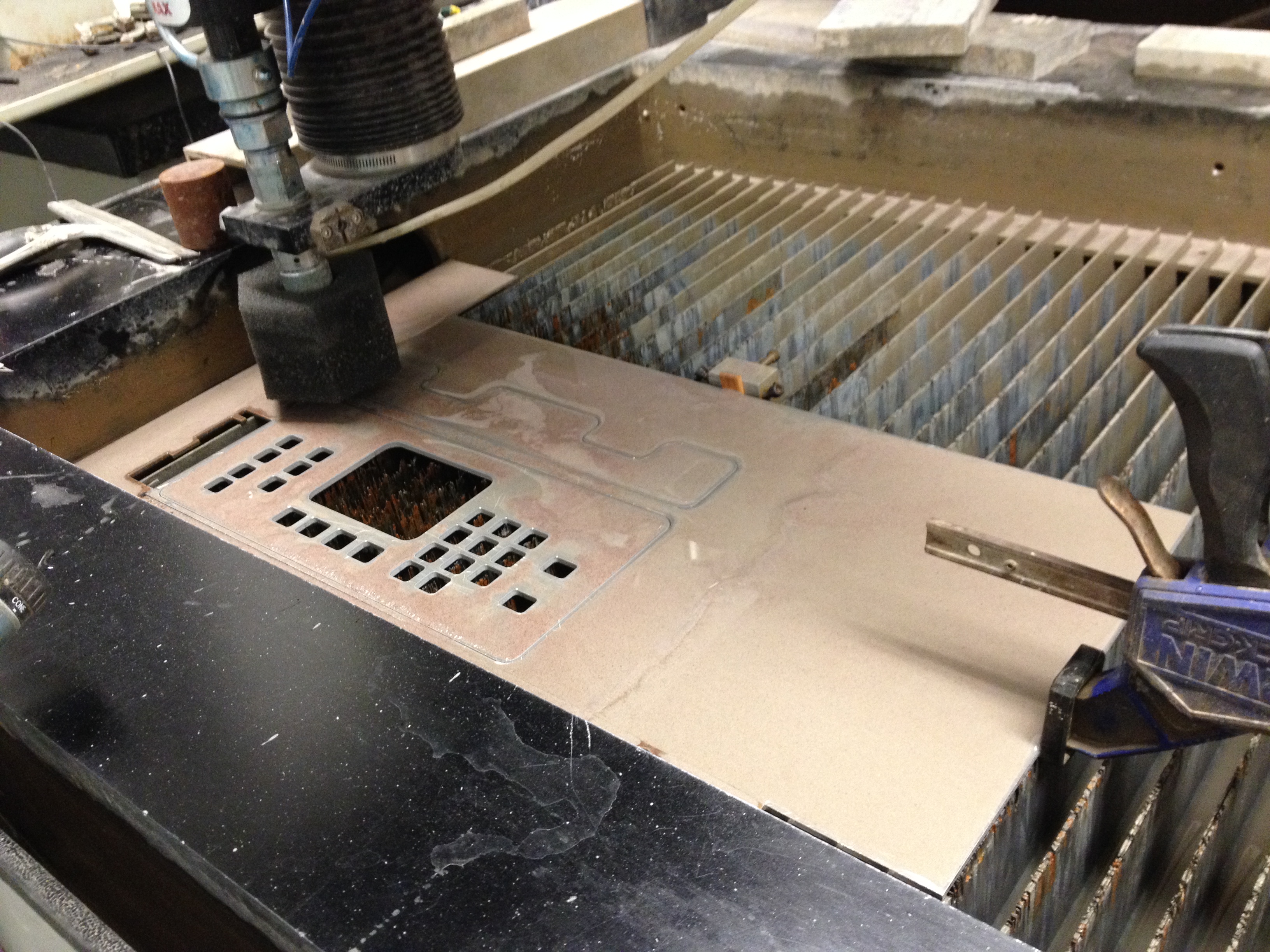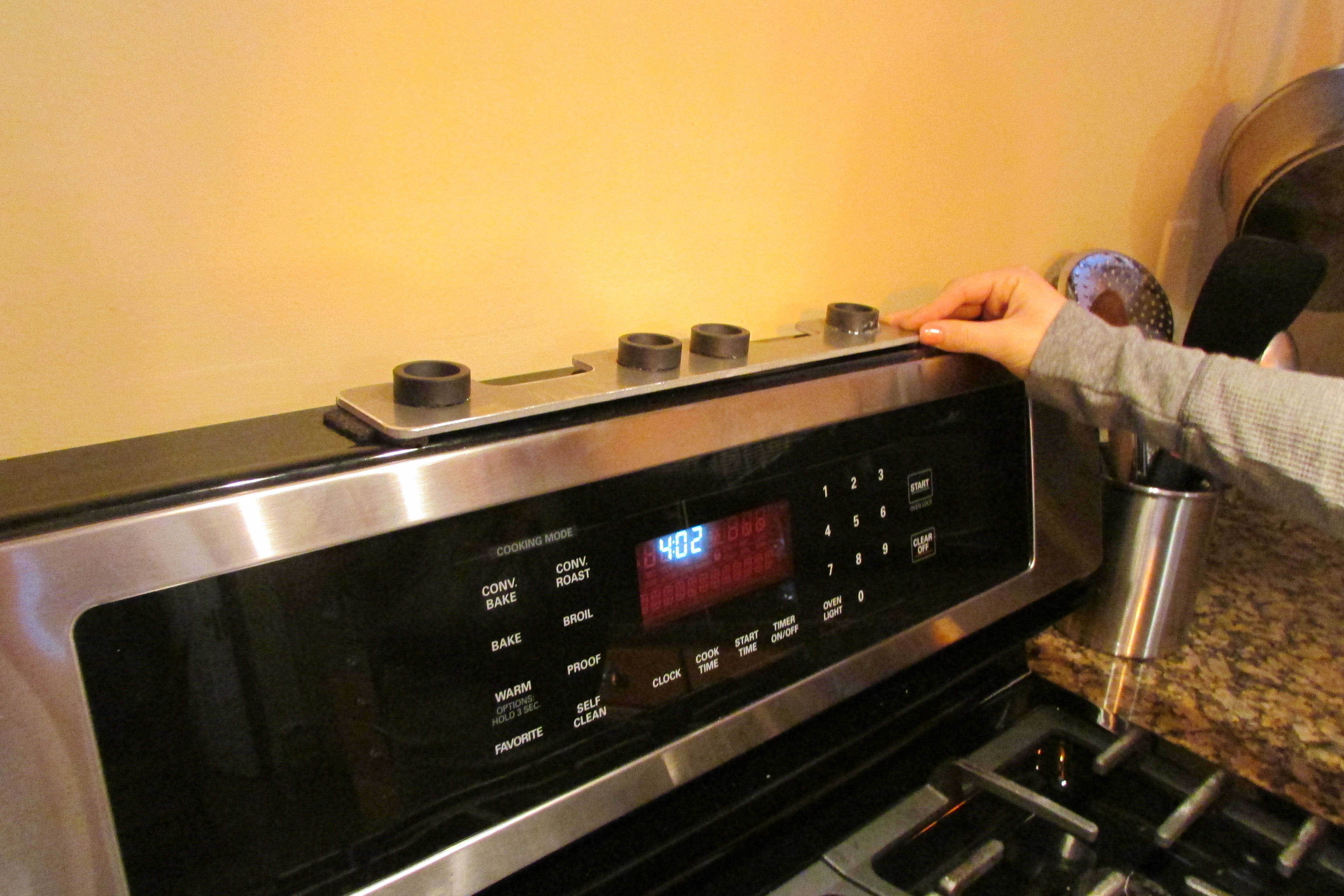An Accessible Overlay for a Flat Touch Screen Panel
December 19, 2013Cost: $51 to $100
Time Needed: 5 to 8 hours
Skill Level: Intermediate
Functional Abilities/Limitations: Complete Loss of Sight, Severe Loss of Sight
About
Top-of-the-line LG ovens (model number LRG3095) are made with a touch screen control panel. These are completely inaccessible to a blind or low vision user, for a number of reasons. The touch screen is ultra-sensitive, which means that even the smallest contact with a button activates it. This means that the user cannot guide his/her finger across the panel without activating the very first button he/she touches. Also, the control panel is completely flat--there are no ridges which outline the buttons. In addition, there is not enough room between buttons to place braille labels down. Finally, there is no verbal feedback to alert the user of which button he/she has pressed. Fortunately, the oven does make a generic beep when a button has been pressed. Additionally, the touch screen does not change dynamically. We created an overlay of the control panel to outline the different buttons for the user. This provides the user with ridges to touch, in order to locate the correct button and touch it. There is also enough room for other information on the overlay, including Braille labels. The user can place the overlay on the oven control panel and remove it when desired. This approach gives the user the independence to press the buttons directly, without needing to rely on external technologies or people. It also gives the user the freedom to store the overlay, in order to not affect the aesthetics of his/her home.Step 1: Make CAD Model.
Extrude a rectangle of a size of the panel plus desired label length to a depth of used aluminum sheet. Create a grid of vertical and horizontal construction lines in places of rows and columns of the panel spacing them according to measurements taken from the oven panel. Create squares centered on the crossings of the construction lines in the places where button holes are required. In order to make batch hole size changes easier one can constrain the side lengths to equal in each square (usually 15mm is well enough for a finger to fit through). Cut out a big rectangle in the place where the panel’s display is so it is visible and to reduce the weight of the overlay. In order to make the overlay safer to use round the 90 degree edges. The inside corners of the button holes should be rounded with approx 3mm radius and for all the other corners 100mm is appropriate. Extrude another rectangle, of the same length as the first one but of a smaller width, around 10mm less than the depth of the top of the oven.
Step 2: Waterjet.
Save the surfaces created in CAD software as files with a format readable by a waterjet cutter (usually *.dxf). Take them to a professional waterjet technician to cut the aluminum sheet for you.

Step 3: File edges.
In order to avoid cuts while using the device and to present and appropriate aesthetic value, the waterjet cut aluminum shapes need to have their edges filed until they are smooth. This can be done using any ordinary flat file. The button holes may require a round file to reach the corner roundings.
Step 4: Put felt down.
Cut out strips of the felt and glue them in the corners of the front piece of the overlay to avoid having it scratch the oven panel.
Step 5: Glue magnets down.
On the back of the support part, use magnetic tape to increase grip with the oven. It’s very important to attached the magnets against the left and right corners. Besides grip, left and right magnets work with the ridge on the top of the oven for horizontal alignment (see item 9). Use superglue to help magnetic tape attachment.

Step 6: Attach hinges.
Use two hinges of size 2 1/2” x 2” (leaf height x width), with three holes each. For positioning, consider the necessary distance between the support part and the main overlay for vertical alignment. Use a drill press to drill holes and tap holes for quarter 28 threaded screws.

Step 7: Clean up.
Use Isopropyl Alcohol 70% for cleaning the panel.
Step 8: Place Braille stickers down.
If desired, create Braille stickers labels and place them on the side, bottom or above the holes (depending on the available room and user’s preference). The letters/words chosen and labeling are crucial for overley success. They have to make sense for the user and be short enough to fit on available space. The following are suggestions:
- Use contracted Braille
- Use first and last letter to identify a word; Ex: CK for Clock
- Use a dash to identify two words. Ex: C-R for Convection Roast

Step 9: Place felt marker on the oven.
For horizontal alignment, add a marker to the top of the oven, so the user can place the support on the top and slide it to the left until he/she reaches the marker. Make it with a tiny piece of black felt, adhesive-backed.
Note: These big magnets on the picture were replaced by magnetic tape underneath the layer.

Step 10: Orient the overlay on the oven.
- Place the top half of the overlay on the top of the oven, such that the main panel is hanging down vertically. Place it all the way on the right-hand side.
- Slide the entire overlay to the left until it hits the felt marker.
Step 11: Use the oven.
- Use the attached operation guide, which describes how to do all of the oven operations (baking, broiling, self cleaning, and more).
- Use your finger to find the desired hole. Move your finger inside the hole to press the desired button.
Section: Cook Time
Press COOK TIME. Enter time in the number pad and press START. This is the amount of time for which you will bake. The smallest unit of time is a minute.
Section: Start Time
Press START TIME. Enter time in the number pad and press START. This is the time of day at which you will start baking. The smallest unit of time is a minute.
Section: Convection Bake
Press CONVECTION BAKE. To bake at the default temperature of 325 degrees Fahrenheit, press START. Otherwise, enter your desired temperature in the number pad. If desired, enter cook time and/or start time. Press START.
Section: Convection Roast
Press CONVECTION ROAST. To roast at the default temperature of 325 degrees Fahrenheit, press START. Otherwise, enter your desired temperature in the number pad. If desired, enter cook time and/or start time. Press START.
Section: Bake
Press BAKE. To bake at the default temperature of 350 degrees Fahrenheit, press START. Otherwise, enter your desired temperature in the number pad. If desired, enter cook time and/or start time. Press START.
Section: Broil
Press BROIL. To broil at the default level of high, press START. To broil at the low level, press BROIL and then press START.
Section: Warm
Press WARM and then press START.
Section: Settings
Hold WARM for 3 seconds.
Convection auto converter. Press 1 to enable or 2 to disable. Press START to set.
Thermostat adjustment. Press WARM once. Enter temperature between -35 and +35. Press START.
Language selection. Press WARM twice. Enter 1 for English, 2 for Spanish, or 3 for French. Press START.
Preheating alarm light. Press WARM three times. Press 1 for light on or 2 for light off. Press START.
Beeper volume. Press WARM four times. Press 1 for loud, 2 for normal, 3 for low, or 4 for mute. Press START.
Temperature unit. Press 1 for Fahrenheit or 2 for Centigrade. Press START.
Section: Proof
Press PROOF and press START.
Section: Favorite
Bread. Press FAVORITE once. Default is bake at 375 degrees Fahrenheit.
Meat. Press FAVORITE twice. Default is convection roast at 325 degrees Fahrenheit.
Chicken. Press FAVORITE three times. Default is convection roast at 350 degrees Fahrenheit.
To cook at the default temperature, press START. Otherwise, enter the desired temperature in the number pads and press START.
If you enter a new temperature, this temperature will be saved as the new default temperature for that particular category of food.
Before you press START, you may also enter in a Cook Time or Start Time if desired.
Section: Self Clean
Remove all racks and accessories. To clean for the default of 3 hours, press SELF CLEAN once and then START. To clean for 2 hours, press SELF CLEAN twice and then press START. To clean for 4 hours, press SELF CLEAN three times and then press START.
Section: Clock
Press CLOCK. Enter time in the number pad and press START. This is the current time of day. The smallest unit of time is a minute.
Section: Timer On/Off
Press TIMER ON/OFF. Enter time in the number pad and press TIMER ON/OFF to set. Press TIMER ON/OFF to cancel.
Section: Clear/Off
Press CLEAR at any time to cancel and start over.
Aids for Daily Living, Blind and Low Vision, Housekeeping
Tags:
BlindLow VisionTouch Screen
Tools Required
- Multipurpose 6061 Aluminum, Sheet, .160" Thick, 12" X 24"
- Ultra Soft Gray F26 Felt Sheet, 1/8" Thick, 12" X 12" Adhesive Backed
- Hinges, Square Corners, 2 1/2" H, 2" W
- Magnetic tape
- Super glue
- Isopropyl Alcohol 70% for cleaning
Materials Required
- Solidworks (any version capable of producing *.dxf files)
- Waterjet
- Drill press
- Files and sandpaper
Safety Precautions
Only use a waterjet machine and drill press if you are trained to use one.